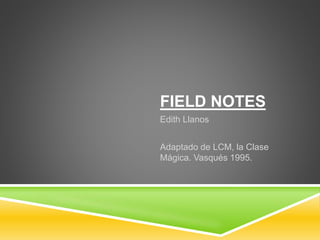Taller fieldnotes & format
- 1. FIELD NOTES Edith Llanos Adaptado de LCM, la Clase M¨¢gica. Vasqu¨¦s 1995.
- 2. HEADING : Name: Lizza Bermudez Email (your email address): lizzabermudez@yahoo.com Site: IE Alberto Lleras Camargo Date: d/m/a Activities: Digital Game, Storyboarding Language: English, more English than Spanish OtherCollaborators: Andr¨¦s Gomez, 11, 6-2 Arley Morales (coordinator), Fernanda Linares(English Class)
- 3. SOCIAL SCENE (Wide Angle View) 1. Describe the broad social scene for those who will read your notes. 2. Illustrate the initial social dynamics you notice when you first arrive at site. 3. Detail the general atmosphere and feelings expressed by others. 4. Describe the people and the relevant physical spaces you encounter. Note any changes across the session to be addressed at length in the next section. one or two paragraphs long. DESCRIPTION OF THE ACTIVITY: (Zoom Lens View) ? Zoom in on your interactions with children and/or adults at site. ? Describe your specific interactions as accurately as you can, in a clinical manner. ? Be careful to report behaviors rather than imputing motive. For example, ¡°Carlos ran in, smiling, jumping and waving a paper.¡± vs. ¡°Carlos was happy.¡± ¡°Happy¡± is a personal judgment with no evidence to support it. REMEMBER TO SHOW NOT TELL.
- 4. DESCRIPTION OF THE ACTIVITY ? Language: Spanish? English? Both? Kumeyaay? Other languages? ? Dialogue: Sometimes, special things that really strike you will be said. Try to remember and record the child¡¯s own words, if possible. ? Roles: What roles did you assume? The children? The adults present? ? Strategies: What kind of strategies were used to choose a game? To problem solve? Was there turn-taking, collaboration & play? ? Goal Formation: Were goals formed? How? Were they accomplished? ? Problem Solving: What were the particular problems to be solved in the game/activity? How did you and your partner(s) handle them? ? Evidence of social and cognitive change: What salient learning behaviors were exhibited by the child/ adult? In early stages of the activity to the end? Was there any change? What was the evidence of change? ? Use of the program structure: Did you and your site partner(s) use the task cards, site folder, write to ¡? Was there resistance? ?
- 5. REFLECTION. (Lens on Self) ? Thoughts and opinions ? What happened at site. ? What have you learned about yourself and others? ? Reflections on how readings from the class are useful in explaining the phenomena at site ? Questions for further exploration in subsequent sessions. ? Describe issues you and the child experienced and how or why you think your learning experience was improved or stifled.
- 6. FORMAT BASED ON LA CLASE M?GICA. V?SQUEZ, 1995 OBSERVAROR NAME:_______________________________________________ SOCIAL SCENE CAPTURE: DESCRIPTION OF THE ACTIVITY THOUGHTS & OPINION. Date Day Month year Beginning at Ending hour Activity Students Collaborators





